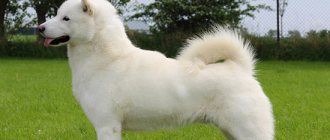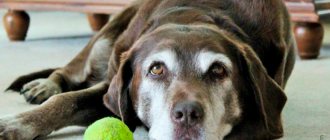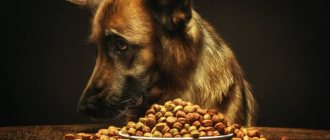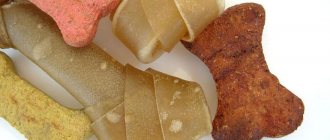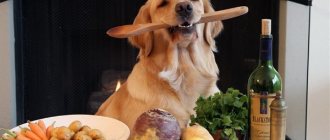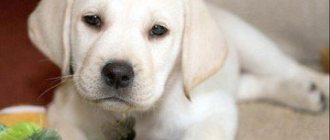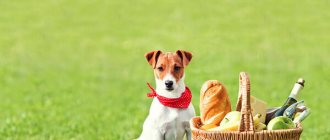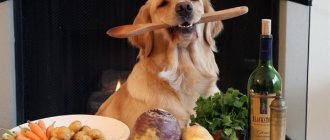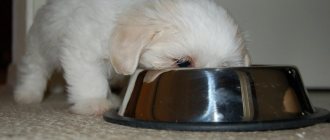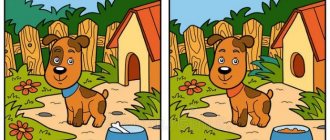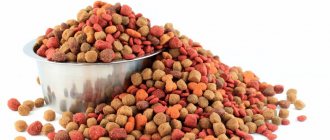Rating of the 10 best dry food for the Golden Retriever
| Place | Name | Rating | Price, rub. |
| 1 | Belcando Junior Maxi for large and giant breed puppies from 3 to 18 months (15 kg) | 10 / 10 | 5 214 |
| 2 | Acana Puppy Large Breed, 11.4 kg | 10 / 10 | 5 050 |
| 3 | Royal Canin Maxi Adult, 15 kg | 9 / 10 | 4785 |
| 4 | Almo Nature Holistic beef 12 kg | 9 / 10 | 4279 |
| 5 | Purina Pro Plan Optiderma for healthy skin and coat, salmon with rice, 14 kg | 8 / 10 | 4113 |
| 6 | Brit Care lamb with rice 12 kg | 9 / 10 | 3999 |
| 7 | OUR DIET WITH BEEF, 15 kg | 7 / 10 | 1670 |
| 8 | Pedigree for healthy skin and coat, beef, 13 kg | 7 / 10 | 1399 |
| 9 | CHAPPI MEAT ABUNDANCE WITH VEGETABLES AND HERBS, adults, 15kg | 7 / 10 | 1381 |
| 10 | ALL DOGS (13 kg) Dry complete | 6 / 10 | 1153 |
Dry dog food is a complete nutritious diet for a pet, developed taking into account the physiology and characteristics of the animal. It contains carbohydrates, fats, proteins, and amino acids in a balanced state. When choosing, pay attention to the composition. The product must contain fats of animal and plant origin and natural ingredients. This is what dogs should receive to be healthy and cheerful.
Proper nutrition for a golden retriever puppy: how to choose
At two to three months, the puppy needs to be fed 6 times. Until the baby is five months old, we feed him 4 times a day. At six months you can switch to two meals a day. Before permanent teeth appear, babies will definitely need yogurt, kefir or cottage cheese every day. Milk is allowed up to six months.
As for the diet, it must contain cereals:
- Millet;
- Rice;
- Buckwheat.
It is better not to feed puppies pearl barley, semolina, barley and wheat porridge, and market mixtures. The life of a puppy is unthinkable without meat. It is best to give:
- Turkey;
- Chicken;
- Veal;
- Beef;
- Rabbit meat;
- Horse meat;
- Nutria.
In any case, the meat should not contain tubular bones. In addition, pork is not recommended for puppies. The ideal processing option is boiling, or defrosting in the microwave after deep freezing. Eggs can be given either raw or boiled, but rarely. We give the puppy fish only without bones. Instead of bones, it is better to take cartilage and joints. From fats, butter and any vegetable oil are allowed, but not margarine.
In total, the puppy should receive 300 g of meat per day and 0.5 kg of milk porridge per day. Vegetables and fruits are needed in the amount of 100 g, fermented milk products - about 150 g.
Is it possible to feed a retriever puppy dry food? It is possible, but there are several conditions. So, the food should be specialized, “for children”. It is better to choose those belonging to the minimum super premium category. The best meat in puppy food is lamb.
Feeding
A natural diet will not be the answer for your pet.
Ready-made mixtures contain the necessary micro- and macroelements, proteins, carbohydrates and fats. The retriever requires high protein, healthy fats, complex carbohydrates, which will provide building material for the formation of bones and muscles, and energy for training. Take the Attention Test! Find 10 differences! (click right here!)
Find the answer Are you bothered by some problem or question? Enter “Breed” or “Name of the problem” into the form, press Enter and you will find out everything about the issue that interests you.
Veterinarians recommend a product class no less than premium. If an animal has digestive problems or food is poorly digested, choose holistic food, the absorption of which reaches 95%. The animal's diet is based on at least a third of proteins.
They were found in lamb, beef, chicken, and fish. To obtain Omega-2 and Omega-6 fatty acids, fish oil is added to the mixture, which improves the condition of the coat, skin and prevents allergies. There are few complex carbohydrates in dry dog food, but they are used as a source of energy. To improve digestion, fiber-rich vegetables, plant fibers and seeds are added to the food.
Nutritional Features
In order for your pet to be happy and healthy, it is necessary to provide it with a complete and balanced diet and correctly determine the daily food intake. Since the weak point of this breed is the pancreas and liver, it is worth paying special attention to the amount of fat (8-16%) and protein (<28%) in the dog’s diet.
A Golden Retriever who lives outside the city and leads an active life needs more high-calorie food than a dog living in an apartment. Vitamins and carbohydrates are found in cereals, natural vegetables and fruits. The source of protein is: meat, sea fish (catfish, cod), meat by-products (kidneys, heart, lungs), eggs, dairy products. During the molting period of the animal, additional feeding must be introduced into the diet; in winter, fish oil and algae are added to the food.
Belcando Junior Maxi for large and giant breed puppies from 3 to 18 months (15 kg)
Many experts recommend Belcando Junior, made in Germany, for large dogs. Its composition is rich in a high content of poultry meat, in addition to easily digestible rice, which helps good digestion and absorption of useful components. The recipe contains carob fruits, which contain tannins and substances important for life that have an effect on proper digestion. Belongs to the super premium class.
pros
- A complete, balanced complex of nutrients.
- Healthy pet.
- Convenient, economical packaging.
- A wide range of.
- Availability.
- German quality.
Minuses
- Causes an allergic reaction.
- Not all dogs like it.
- Not sold in all Russian cities.
- Composition with sodium chloride.
- Large granules of strange color.
- Poor combination with vitamins and other products.
- There is a minimum of meat, but a maximum of cereals.
Acana Puppy Large Breed, 11.4 kg
Acana Puppy appeals to every furry friend and turns into a favorite bowl. Transforms the animal's fur into smooth and silky, bones will be stronger, and more energy will appear. Thanks to these crackers, your beloved friend is provided with a balanced diet. Many breeders of our smaller four-legged brothers recommend them to everyone else. This is a holistic class.
pros
- Natural.
- Without smell.
- Large packaging.
Minuses
- High price.
- There is a fishy smell.
Royal Canin Maxi Adult dry for large breed dogs, 15 kg
The animal receives a complete diet thanks to Royal Canin. It is designed for individuals weighing from 26 to 44 kilograms, aged from 15 months to 5 years. Its dry granules contain a unique complex of nutrients that helps the digestive system function optimally. They contain a lot of protein, creating a balance with dietary fiber. Royal has natural taste properties with an aroma that evokes excellent appetite in our smaller four-legged brothers. Category: premium.
pros
- Balanced composition.
- High quality.
- Promotes good digestion.
- Maintaining optimal shape and weight.
- Healthy coat, skin, teeth.
- Convenient, practical packaging.
- The pet likes it.
- Gives activity.
- The crackers smell nice.
Minuses
- The packaging is made of paper and does not close after opening.
- Unattractive looking bag of granules.
- Possible only from 15 months to 5 years.
If the choice fell on a natural diet
Many veterinarians and experienced breeders believe that it is correct to feed a Labrador puppy those dishes that were prepared by the owner himself from products that are not in doubt.
This does not mean those dishes that are prepared for the whole family (borscht, cutlets, navy pasta, etc.), but what is prepared specifically for the dog, taking into account all its needs. As a rule, the puppy actively suckles at the mother's breast until 2-3 weeks; around this time, the first complementary foods are introduced in the form of a small amount of boiled meat, turned into puree. And already from 1-1.5 months, puppies begin to eat almost the same as adult dogs. The menu for a Labrador puppy aged 1 to 3 months should include a lot of dairy products - about 50% of the total food (this includes milk, cottage cheese, and fermented milk products). Approximately 20% of food should be meat (including offal, fish), 15% each should be cereals and vegetables. From the moment the puppy turns 3-4 months old, the situation with the amount of dairy products in the diet changes slightly. At this age, the animal requires more meat - at least 50% of the total food volume, but the share of milk dishes decreases to 20%, vegetables and cereals still account for 15%.
Almo Nature Holistic beef 12 kg (for large breeds)
Italian crackers of excellent quality with meat additives do not violate European standards. They have the aroma of real meat, causing an excellent appetite in your beloved pet. They contain protein, but in minimal quantities. The animal receives adequate nutrition by consuming it regularly. Almo Nature belongs to the super premium category.
pros
- Dogs love its taste.
- Hypoallergenic.
- Wide range of tastes.
- Fresh natural ingredients.
- There are no artificial additives, dyes, preservatives, or flavors.
Minuses
- Sometimes causes hair loss.
- The pet may refuse to eat it.
Purina Pro Plan Optiderma for Healthy Skin and Coat, Salmon with Rice, 14 kg (Large Breeds)
A healthy body and the well-being of an animal are the result of its optimal nutrition. Purina Pro Plan was developed by Russian veterinarians and nutritionists. The composition includes specially selected nutritional components for four-legged pets of different sizes, weights and ages. It suits even special preferences and keeps the animal in excellent condition. Belongs to the premium class.
pros
- Decent composition.
- Wide range for any age, size.
- Nutritious with all the vitamin complex.
Minuses
- Flavoring additive.
- Doesn't cause much appetite.
- Not available everywhere.
- Creates increased gas formation.
Personality of the Golden Retriever
A fairly calm character is a distinctive feature of the breed. The Golden Retriever is a classic companion dog. These animals are obedient, friendly and friendly, getting along well with children, as well as with strangers. A retriever is unlikely to make a good guard dog. After all, these animals love people very much and easily make contact with them. Golden retrievers are held in special esteem by hunters. These dogs, thanks to their incredibly keen sense of smell, became their faithful helpers. The sense of smell is also why dogs are often used to sniff out drugs. These dogs are suitable for large, active families.
Brit Care lamb with rice 12 kg (for large breeds)
The food is produced in the Czech Republic. It is rich in protein due to the significant amount of natural meat and fish in the recipe. Rice is used, enriching the body with carbohydrates, including fish and chicken oil, which produce fatty acids. Brit Care is most useful for large breeds, because its components prevent joint diseases - a problem for many large four-legged pets. Premium and super - premium class.
pros
- Vitamins and minerals in balance.
- Hypoallergenic.
- Nice smell.
- Causes a huge appetite.
- Optimal size granules.
- High quality.
- For a healthy pet's body.
Minuses
- It smells strong.
- Unpleasant color.
- Too dry.
- Not suitable for all breeds.
- Insufficient bag volume - up to 12 kilograms.
Ready-made food - easily digestible food for retrievers
Premium and super-premium ready-made food offered by manufacturers contains all the microelements, vitamins and nutrients necessary for the full growth and development of a dog. Animal protein does not contain antibiotics or hormones. When developing a line of industrial food for Golden Retrievers, the characteristics of the breed and the predisposition of individuals to diseases such as obesity, hip dysplasia, allergies, and disorders of the gastrointestinal tract were taken into account. If your four-legged friend suffers from allergies, then it is better to choose food based on lamb or salmon. Dogs of this breed will also benefit from food designed for large breeds. Professional food has a formula that is easily digestible by animals and supports the metabolic processes occurring in the four-legged body at the proper level.
Experienced breeders and veterinarians advise:
- For stable functioning of the nervous system of golden retrievers, choose food enriched with vitamin B;
- Use food from well-known brands: Iams, Eagle Pack, Wellness, Eukanuba and Canidae;
- Soak dry food in boiled water before giving it to your dog to prevent gastric volvulus. This is especially true for small puppies and juniors under the age of 1 year.
OUR DIET WITH BEEF, 15 kg
OUR DIET, produced in Russia, provides the body of four-legged pets with the entire complex of nutrients, vitamins, and minerals that are so necessary for health. The composition contains natural ingredients, probiotics that support the immune system. The dog is healthy and active all day long thanks to fatty acids, chicken and salmon fat. The listed components are present in the specified diet. Considered economy class.
pros
- Qualitative.
- The dog eats with pleasure.
- Gives activity to the animal.
- The fur shines and shines.
- Well absorbed.
- Choice of flavors.
Minuses
- Large granules.
- Cats eat.
- Only for large representatives of the breed.
Pedigree for healthy skin and coat, beef, 13 kg (for large breeds)
PEDIGREE helps reduce the risk of tartar and plaque formation on your pet’s teeth. Provides him with normal digestion. It is preferable to feed your pet dry food in a container separate from wet food, and ensure the availability of fresh drinking water. This is quite healthy, tasty dog food. It is produced taking into account the physiological needs of a large four-legged pet. The food is produced by a Russian company and is designed for the economy category.
pros
- Convenient packaging.
- Pleasant aromatic and taste properties.
- The pet eats with pleasure.
- No artificial flavors.
- High quality crackers.
- Comfortable in using.
- Lots of vitamins.
- The coat takes on a healthy, beautiful appearance.
Minuses
- Negative reputation.
- Missing useful components.
- Worse than normal nutrition.
- Doesn't do any good.
- Harmful to the health of the animal.
- The pet quickly gets used to this food and does not eat anything else.
- Increases salivation.
CHAPPI MEAT ABUNDANCE WITH VEGETABLES AND HERBS, adults
CHAPPI is produced in Russia for economy class. It contains cereals, which are considered the best sources of carbohydrates. Proteins are present in the form of meat and offal. Use vegetables, for example, carrots, vegetable oils. CHAPPI is convenient because there is no need to add vitamins to it; they are already contained in sufficient quantities.
pros
- Wide availability.
- Nutritious food.
- Does not cause constipation in the animal.
- Decent quality.
- Promotes healthy appearance of coat and teeth.
- Doggies like it.
- There are no artificial flavors or flavor enhancers.
Minuses
- Treatment of the animal after eating these dry granules.
- Bad composition.
- Allergic reactions.
- Hair falls out.
- Bloating.
- Not suitable for all individuals.
- Unattractive packaging.
ALL DOGS (13 kg) Dry complete
ALL DOGS, according to many dog breeders, is considered a complete diet for our smaller four-legged brothers of any breed, size, age and activity level. Each owner adjusts its portions according to the needs of their pet. Together with it, the pet receives a complex of essential nutrients for life. The food is produced in Denmark, based on the latest research on pet nutrition and international standards, which indicate recommended levels of nutritional content. It belongs to the economy class.
pros
- Suitable for almost all breeds.
- Quite popular due to its excellent composition.
- Induces pleasure while eating.
- Excellent oral hygiene and plaque removal.
- Does not contain GMOs, excess or artificial additives.
Minuses
- Not suitable for everyone.
- Insufficient amount of protein.
- You need to add vitamins and natural meat.
- Poor assortment from the manufacturer.
Most of the listed types of dry food, we recommend paying attention to Belcando Junior Maxi and Royal Canin Maxi Adult in the ranking of the best.
This food is based on natural ingredients. Proper nutrition is the key to a healthy body and excellent physical condition of any animal.
The price of these feeds is high, but it is worth it. Moreover, they contain all the useful components, including vitamins, and your beloved pet receives adequate nutrition.
Feeding recommendations for large breed dogs
Large dogs have no less appetite. Individuals with large dimensions have a slower metabolism, they need fewer calories and fat, and they require a higher protein content to maintain shape.
Dry food for large pets varies in granule sizes. For large animals, they are produced about one and a half centimeters in diameter. A smaller granule size will not provide the jaws with full function, which is important for the dog’s health.
Adult pets are fed twice a day, after morning and evening walks. Breakfast and dinner take no more than a quarter of an hour. The bowl is removed even if the food is not eaten. The animal should always have access to clean, fresh water.
The daily amount of food for animals is not the same for equal sizes. It depends on the load experienced by the pet since the last meal. If your pet actively trains or spends a lot of time walking outside, the serving size is increased by a third. If the load is reduced, the pet does not walk much, rests or sleeps more time, the portion is reduced by about 15 percent.
The main indicator of a proper diet is a healthy, well-fed, strong dog whose weight is within the normal range for its age.
Large active animals, service animals, workers, need high-quality nutrition. Suitable feeds marked “energy” or “active”, varieties of “super-premium” or “premium” classes. They contain enough calories, are nutritious, and help improve the digestive system. This diet includes vitamins, dietary supplements, proteins, and amino acids.
It is impossible to give the animal food before training, an active walk or immediately after. Large dogs are at much higher risk of developing volvulus or intestinal blockage than their smaller dogs. These situations are dangerous and require urgent veterinary intervention. After a significant load, you can give the animal to eat after about one hour.
Raising a Golden Retriever puppy: feeding by month
For a newborn puppy, the only food is mother's milk. Until about 6 weeks they refuse complementary foods. Many breeders begin to feed puppies with industrial food, adding some natural products (meat, cottage cheese). But the owner can decide for himself what to feed his golden retriever puppy. The main thing is to monitor the quality of the food and the puppy’s reaction to it. Weight gain and healthy appearance will be the main indicators of the puppy’s feeding quality.
Feeding by month, namely the selection of diet and calculation of portions, is very individual and depends on the breed, gender, and weight of the puppies. How to properly feed a golden retriever puppy by month is best determined by focusing on a specific animal, namely its weight gain. For Golden Retriever puppies, standard feeding schedules and rules are quite suitable (see the article Puppy Feeding Schedule - Feeding Tables and Charts). It is worth remembering that the Golden grows rapidly up to 6 months and its weight at this age can already be 25 kg.
Feeding by month provides not only an increase in portions, but also the introduction of one or another product. For example, for goldens up to 3 months old, half of the diet is recommended to consist of cottage cheese, since its skeleton is rapidly developing and calcium is vital for it. Later, the amount of cottage cheese can be reduced in favor of meat, and from 4 months it is allowed to include offal (liver, lungs, heart, spleen).
And finally, remember:
- the pet must always have access to fresh water;
- useful additives when feeding natural food are welcome;
- Under no circumstances should you feed your Golden with food from your table!
What vitamins are needed when feeding large breed dogs?
Vitamin complexes are an essential element of the diet of dogs fed boiled meat, offal and vegetables. But when feeding dry food, you may need to take additional vitamins. So that the supplement contains:
- Vitamin C is needed for the functioning of the immune system and ensures the full development of the muscular system, bones, joints, and teeth.
- Vitamin D - used for the formation of the skeleton, especially needed by puppies during the first year of their life.
- Calcium is absorbed along with vitamin D, used to form teeth, skeletal bones, and makes the coat beautiful and shiny.
For large dogs, vitamin complexes are suitable - Beaphar Top 10 Chondro Treat, Unitabs Immuno Complex and others.
How to Feed a Large Breed Dog Puppy as opposed to an Adult Dog
A young animal cannot be fed in the same way as an adult pet. If the size of the puppy exceeds the height of a medium-sized dog, its bones, teeth, and gastrointestinal tract are in the development stage.
This imposes restrictions on the diet:
- Overfeeding and underfeeding a puppy will be equally harmful. But feeds usually contain tables that can be used to calculate the required volume of feed depending on the weight and age of the pet.
- The number of feedings depends on age. At 2 months, puppies are fed up to seven times a day, distributing food evenly throughout the day. By the age of one year, the number of feedings is gradually reduced, bringing it to 2 or 3 times a day. Sudden changes in the amount of food should not be allowed.
- Regardless of whether the pet eats dry food or natural products, it must have access to clean water or milk around the clock. This is especially important for puppies; when eating dry food, there is a high risk of dehydration.
When purchasing a puppy, it is important to discuss with the breeder what the animal ate before the move. It is impossible to abruptly change the diet from natural food to dry food or vice versa. This leads to problems with the stomach, which is sensitive in the young individual.
In case of food intolerance, puppies experience diarrhea or constipation, and allergic reactions are possible. Small dogs are prone to them; large breed puppies do not yet have strong enough immunity. The transition from one type of food to another or changing the brand of food is carried out smoothly and accurately.
Feeding your Golden Retriever.
Recommendations of the Breeder for owners of puppies from the Kibelline kennel.
Nutrition. Feed.
1. Before purchasing a puppy, you need to clarify what brand of food the litter from which you have chosen the puppy is accustomed to.
2. You can ask for some food for you and your puppy for the first time.
3. The nursery also provides the opportunity to purchase food that the puppy is accustomed to at an attractive price.
4. For a puppy aged 1.5 - 2 months, a 15 kg bag of food will last for about 1.5 months. From 3-4 months to 9-12 months. nutritional requirements for growth increase sharply, and a 15 kg bag of feed is consumed in a Month.
5. Feed cost from 3,500 minimum to 5,400 maximum for 15 kg
6. At first, it is better not to change the puppy’s food; later you can switch to another food, for example, of a more decent composition or better eaten by the puppy.
The choice of food for puppies and mother bitches is always an “individual selection”, justified:
1. taste preferences of puppies and mother,
2. allergy to food and skin reaction,
3. digestibility of feed and reaction from the gastrointestinal tract,
4. excellent weight gain and condition of the puppies in the litter.
5. availability of feed in the city/region,
6. Availability of special offers for food and the price of food.
Raising puppies on high quality food is a mandatory condition for all co-breeders of the kennel, for all puppies bearing the name Kibelline.
Of course, we are very upset if for some reason, be it amateurism or financial difficulties, puppies eat low-quality food.
A good Start is very important for further development. It is given by the breeder from 1 to 2-3 months, the main formation of the dog is completed at 12-15 months.
and yes... Even the brightest prospects can be “ruined”, even “show class” and “first choice”, therefore the issue of nutrition must be approached responsibly!
It is very important to pay attention to the COMPOSITION of food and feeding rates.
To make it easier to navigate the variety of dog foods, we suggest you use
NAVIGATOR for dog food
In this section we have included feed brands that have been tested by time and by us personally,
our champions, puppies, adult dogs and veterans.
Adding natural ingredients to food? Is it possible? If necessary?
The only justification for adding natural food or canned dog food to dog food is poor appetite:
- in bitches during estrus and pregnancy,
- in puppies during teething changes
- in dogs, regardless of age, as a reaction to stress, moving, etc.
As a rule, the Golden tolerates the addition of a small amount of 1 tablespoon of various natural food per 1 Cup of food (high-quality, freshly prepared, and not something that was lying around and someone needs to finish it) or dog biscuits or black bread in small pieces in dry food for aroma at the rate of 1 tablespoon per 1 measuring cup of food. Adding a large proportion of natural nutrition to ready-made dry food disrupts the precisely balanced, scientifically verified composition of the food. This either impoverishes nutrition to a very large extent, or significantly complicates its absorption, or both.
Feeding frequency
At the age of 1-2 months
- Food is offered to the Puppy 5-6 times a day 2.
- Drinking water. Water d.b. always fresh, filtered and freely available in a volume of 2 liters.
- Water + Royal Canin mousse starter 2-3 rubles a day is an excellent remedy for a retriever spilling water and for bathing in a bowl of water.
At the age of 3 months, the number of feedings is gradually reduced to 4. The food is given in a soaked form, it can be dry if the puppy refuses soaked food from 3-4 months.
From 4-5 months to 9 months of age. the number of feedings is 3 times a day. The food can and should be given in dry form.
Over the age of one year, the dog needs to be fed 2 times a day.
* It is important that the dog eats the entire amount of food per day.
Attention!
1. As the puppy grows and the dog gains weight, the amount of food consumed increases!
2. Follow the recommendations on the packaging.
3. During the growth period, a Golden Retriever puppy gains weight from 0.8 to 1.5 kg per week!
4. Weigh your dog regularly - this will allow you to control the lack and excess of your pet’s condition.
5. A growing puppy eats as much or even more than an adult dog of the same breed.
6. During the period of teeth change, a decrease in appetite is possible, and poor appetite may also indicate that the puppy is unwell; you need to measure the temperature, observe, and call the breeder. Poor appetite can be a reaction to very hot weather, to a small number of walks, if the puppy does not spend the energy it receives.
7. An adult dog eats 2 times a day, usually after a walk in the morning and evening. It is recommended to feed the “vacuum cleaners” that pick up on the street 30 minutes BEFORE a walk.
8. The dog does not need to change food frequently. Nutrition should be Balanced, Complete, Corresponding to physiological needs and EVERYTHING! According to experience, changing 5-6 diets in puppyhood - junior age, as well as frequent changes of diets for an adult dog, naturally leads to Gastritis, a torn pancreas, and poor condition.
9. Don’t humanize dogs and their taste preferences. In nature, canines eat the same thing all their lives - this is normal. It is easier for a dog’s gastrointestinal tract to adapt to a monotonous food with a stable composition and assimilate it than to constantly adapt to the compositions of different brands or “natural food”.
Transfer to a new type of feed
Change of feed, if necessary, should be done gradually, over a minimum of 5-7 days:
| 1st day | Habitual diet 75% | New diet 25% |
| 2nd day | Habitual diet 75% | New diet 25% |
| 3rd day | Habitual diet 66% | New diet 34% |
| 4th day | Habitual diet 66% | New diet 34% |
| 5th day | Habitual diet 50% | New diet 50% |
| 6th day | Habitual diet 50% | New diet 50% |
| 7th day | Habitual diet 33% | New diet 66% |
| 8th day | Habitual diet 33% | New diet 66% |
| 9th day | Habitual diet 0% | New diet 100% |
*Within the same brand, food can be changed 2-3 days in advance; as a rule, this does not cause problems.
Allergy to food.
1. If the dog’s fur “turns pink”, the ears “flow”, the elbows “red”, the dog sheds heavily and at the same time itches – the diet needs to be changed.
2. These are signs of allergies and individual intolerances that can occur to any even high-quality food or natural food product with a constant, and sometimes even one-time, intake of the allergen into the body.
3. Before blaming the occurrence of an Allergy to food, it is necessary to clearly establish the fact that:
- The dog didn’t steal or pick up anything anywhere.
- you didn’t give her new treats during training or at home,
- None of your house guests or children gave anything to the dog either.
4. A dog may have individual sensitivity to certain components of natural food, the failure of which is expressed, as a rule, by diarrhea or skin rashes. Watch your dog and you will gradually understand what you can give him and what he cannot.
5. Try to do without experiments: without sweet, fatty, smoked, salty and fried foods, otherwise the liver, kidneys, stomach, pancreas and skin will quickly remind themselves of themselves in the form of problems and bills from the veterinarian.
Water.
We recommend that you use purchased water or filtered water for drinking and cooking (built-in filters or Aquaphor-type pitcher filters) both when kept on dry food and when fed a natural type of feeding.
Good water quality is one of the important factors affecting overall health, just like in humans. High water hardness (from a well or due to specific geography) contributes to the formation of tartar and gum problems in dogs. A water softening cartridge will help you prevent plaque hardening and tartar deposits. It is clear to everyone about chlorine, phenols and heavy metals that it is advisable to filter them out. Yes, including the dog - filter! Water should always be freely available to the dog and in sufficient quantity. The 2.8 liter bowl should be full before you leave for work. In the evening, the dog's water is topped up so that there is enough for the night. After walking and in hot weather, the need for water is very high. The food bowl and water bowl are washed with soap and the water is completely refreshed at least once every 2-3 days and always after other people's dogs have drunk or eaten from it - your guests who do not live with you personally, whose health you cannot to be sure.
How to feed pregnant large breed dogs
A lack of nutrients in a pregnant bitch's diet will harm her and her puppies, as will an excess of them. Before mating, the dog is given high-quality dry food for adult animals. Once pregnancy is established, there is no sudden change in diet. Portions remain the same while the dog is in the early stages of pregnancy. Excessive nutrition at this stage leads to obesity, which increases the risk of complications during childbirth and endangers the lives of the dog and puppies.
In the third week, the animal may refuse food for up to a week. Active development of the offspring begins in the fifth or sixth week, at which time the daily portion is increased. The serving size is increased by about one third.
As for the brand and class of food, there are groups of food for lactating and pregnant females. Some breeders replace them with puppy food. They contain many useful substances that the expectant mother needs: calcium, phosphorus, vitamins A, E, C and D. It is acceptable to use food of the “holistic” and “super-premium” classes.
Supplements for pregnant bitches improve the well-being of the female and ensure the health of the offspring. Products such as “Quantum ICD Dog-Mama” relieve toxicosis, “Farmina Vit-Active for pregnant and lactating dogs” compensates for the lack of vitamins and minerals, “Unitabs MamaCare” is easily absorbed by animals thanks to its natural flavoring.
What to feed a Labrador Retriever
Feeding a Labrador Retriever
It is recommended to feed an adult dog 2 times a day. Owners set their own feeding time for their pet, depending on their daily routine. If the dog refuses food for any reason, you must call a veterinarian - the animal may be sick.
In order for the dog to always remain healthy and beautiful, in addition to meat and various types of ready-made food, it is necessary to include food of plant origin, dairy products and mineral mixtures in its diet.
IT IS NOT RECOMMENDED TO FORCE YOUR DOG TO EAT WHAT IT DOESN'T WANT
The Labrador Retriever should be fed meat (tendons, heart, lungs, kidneys, liver, stomach), fish (cod, catfish), vegetables (cabbage, turnips, onions, pumpkin, carrots), fruits, cereals (semolina, rice, millet, oats, rye, buckwheat) and milk mixtures. THE DIETS OF LABRADOR PUPPIES UP TO 3 MONTHS INCLUDE NOT FOOD, BUT MEAT, DAIRY PRODUCTS, CEREAS AND CANNED PEACES, DESIGNED SPECIFICALLY FOR PUPPIES Moreover, meat products are best given to dogs in the evening, and milk and vegetable mixtures are best given to dogs in the evening. in the morning. During feeding, the retriever may dirty the floor. To avoid this, it is recommended to place a newspaper or a board with a cut hole for the bottom of the bowl under the food bowl. Determining how much food your pet needs daily is quite simple. It is necessary to carefully observe the pet for 2-3 days. If the dog eats greedily and licks an empty bowl for a long time, it means that there is not enough food for it, but if the animal eats slowly or its stomach becomes very bloated while eating, the retriever is overeating. The dog’s daily diet must correspond to age and activity she exhibits.
Sources of fats for a Labrador A complete diet for a Labrador must include fats of both plant and animal origin.
BUTTER IS A VALUABLE SOURCE OF ANIMAL FAT
A deficiency of fat in the diet of a young dog can lead to undesirable consequences: slower growth and development, skin diseases, vitamin deficiencies, disruption of normal coat pigmentation and other pathological conditions. However, excess fat in the body is also harmful to the animal, which can lead to obesity and some other diseases. A valuable source of animal fats are products such as goat and cow milk, sour cream, and butter. They are distinguished by a high content of vitamin A, as well as other substances useful for the body of a growing pet: choline, tocopherol, phosphatides. Vegetable fats are found in cereals and vegetable oil.
The composition of vegetable oil includes polyunsaturated fatty acids and vitamin E - vital components with which animal and dairy fats are enriched to a lesser extent. The presence of polyunsaturated fatty acids in a dog’s body contributes to its rapid growth, increased immunity, strengthening the walls of blood vessels, and activation of metabolism in the body animal. It is necessary to add products such as butter, vegetable oil or rendered beef fat to the dog's food, especially in soups and cereals prepared without the addition of milk. A sign that the pet is receiving the optimal amount of fat for it is the attractive appearance of the coat . Smooth, even, thick and shiny fur also indicates a sufficient amount of vitamin E in the animal’s body.
Sources of vitamins for Labrador Retrievers Vitamins are vital for the dog’s body. Their deficiency leads to a decrease in the vitality and resistance of the animal's body, and also negatively affects its reproductive abilities. Depending on the ability to dissolve, vitamins are divided into fat-soluble (A, D, E, K) and water-soluble (C, group B).
FRUITS AND VEGETABLES CONTAIN LOTS OF VITAMINS ESSENTIAL FOR DOG HEALTH
The owner of a dog needs to know what vitamins are necessary for his dog.
Vitamin E. Needed for normal reproductive activity. Vitamin H. Affects the reproductive abilities of animals, as well as fat metabolism and the normal functioning of the skin. Vitamin C. To maintain the natural balance of substances in the body, the dog needs to consume a certain amount of ascorbic acid daily, while in stressful situations, the norm of vitamin C increases by 2, and during pregnancy - by 3 times. Vitamin A. Necessary for growth, improvement of reproductive functions, normal functioning of the nervous system and good vision of the pet. Vitamin B2. It is part of enzymes that regulate oxidative processes in cells. Vitamin B2 is also involved in carbohydrate, protein and fat metabolism. Vitamin B3. Participates in the synthesis of fats and proteins and affects growth, coat, skin tissue and the functioning of the nervous system. Vitamin B6. Part of the enzymes involved in the breakdown of amino acids. This vitamin takes an active part in protein metabolism and affects the content of hemoglobin in the blood. Vitamin B9. Promotes normal development of the coat, stimulates and regulates the process of hematopoiesis, preventing anemia. Vitamin B12. Plays a huge role in the body's use of animal protein and is involved in the metabolism of certain amino acids.
PUMPKIN IS A SOURCE OF MANY VITAMINS
Vitamin D. Participates in phosphorus-calcium metabolism in the body of animals, ensures normal growth and development of bones. When giving animal owners any recommendations on feeding, experts take into account such factors as the age, breed and temperament of the dog, the climatic conditions in which it contained, etc. Vitamin K. Promotes normal blood clotting. Unfortunately, there is no consensus on the exact amount and types of vitamins that a dog needs for normal functioning. Vitamin A is necessary for young dogs. Its deficiency has an extremely negative impact on the health of the animal, negatively affects the functioning of the digestive tract, and a deficiency of B vitamins leads to dysfunction of the immune system. If there is a lack of vitamin A in an animal’s body, its eyes begin to water, digestion and the development of reproductive organs are impaired. Also the activity of the upper respiratory tract may be disrupted. A lack of vitamin E (tocopherol) leads to the dog’s coat losing its shine and looking disheveled. If there is a lack of tocopherol in the animal’s body, irreversible changes in the muscles can occur and infertility may develop. A lack of vitamin C weakens the immune system, and this leads to the occurrence and development of many diseases, in particular scurvy. Symptoms of the disease: depression, loose teeth, sore gums. In order to prevent scurvy, it is recommended to give the dog daily ascorbic acid dissolved in drinking water. Normal development of the skeleton of puppies is possible only when vitamin D, which is responsible for calcium-phosphorus metabolism, is present in their body in sufficient quantities. Calciferol prevents the development of rickets in puppies. Vitamin D deficiency leads to dysfunction of the musculoskeletal system, curvature of the paws, spinal column, as well as delayed development and growth of the dog.
FRESH GREENS – A VALUABLE SOURCE OF VITAMINS
An excess of retinol in an animal’s body leads to accelerated bone growth, resulting in improper skeletal development. A lack of vitamin B1 (thiamine) in a dog’s body leads to general weakness and digestive disorders. A deficiency of pantothenic acid leads to liver dysfunction, and an insufficient amount of folic acid leads to anemia .When a dog lacks vitamin B6 (pyridoxine), it experiences a sharp decrease in body weight and the functions of the musculoskeletal system may be impaired. A lack of vitamin B12 (cyanocobalamin) leads to baldness of the animal. A deficiency of vitamin K (phylloquinone) develops as a result of long-term treatment of the dog with antibiotics and leads to loss of appetite and increased irritability. To compensate for vitamin deficiencies, especially in spring, dogs’ diets include a supplement consisting of a mixture of finely chopped onions, spinach, dandelion, parsley, lettuce, and nettles. Before feeding the puppy, nettles should be scalded with boiling water and cooled, and dandelion leaves should first be immersed in salted water for several hours to remove bitterness from them. Foods containing a large amount of vitamins include fruits, vegetables (carrots, turnips), herbs (parsley, lettuce, spinach, dandelion leaves, garlic, onion), cereals (buckwheat, oatmeal, rice, millet).
OLIVE OIL CONTAINS HIGH QUANTITIES OF VITAMIN E
Fruits and vegetables cannot be called staple foods, but they must be included in a dog’s diet. They are a source of many vitamins: nicotinic acid, carotene, vitamins C and K, folic acid, as well as mineral salts: potassium, iron, magnesium, phosphorus. As a treat, the animal should be given dried fruits - raisins, dried apricots, prunes and apples. They are rich in vitamins and dogs really like them. Dried fruits can be soaked in warm water and crushed added to porridges and salads. Dogs willingly eat not only vegetables, but also fruits. Vegetables can be given to your dog either raw or processed. To pamper your pet with an original vegetable salad, it is recommended to take some peeled turnips, grate them, and season the resulting mass with kefir and vegetable oil.
FOR PREPARATION OF FEED ONLY FRESH PRODUCTS ARE USED
From 2 months of age, you can give your baby carrots, grated on a fine grater and mixed with sour cream or a small amount of vegetable oil. It is allowed to include mashed apples and any berries that the dog likes in his diet (the seeds should be removed first). Many animals happily eat strawberries and raspberries, as well as apricots, pears, cherries, cherries, and watermelons. It is necessary to add greens to the retriever’s food daily. Garlic is especially useful and can serve as an ideal remedy for worms. One crushed clove is mixed with the main feed. In winter, garlic supplement serves as an additional source of vitamins. A proven remedy against worms is raw pumpkin seeds, peeled. Boiled pumpkin pulp and beets are rubbed through a sieve or crushed on a grater and given to the dog along with porridge. It is advisable to feed potatoes only raw. Turnips, cabbage, zucchini, and rutabaga are usually stewed or boiled and given to the dog as an addition to meat food. In addition, these vegetables, as well as cucumbers and greens, can be included in the pet’s diet without heat treatment, but only by peeling and cutting into small pieces To feed your dog, you can also prepare a mixture of porridge and boiled vegetables. For stewing, weak meat broth or water is usually used.
Balanced nutrition for an adult Labrador Retriever The correct diet is compliance with the frequency and quantity of feedings, compliance with the norms of food consumed by the dog, its age, health status and energy expenditure. The daily diet is determined not only by age, but by other factors. The main ones among them are the pet’s gender, its height, weight, fatness, place of detention, as well as the work performed by the dog and the physical stress it experiences.
Components harmful to the health of a Labrador Retriever The diet of dogs living within the city is often incomplete because it contains insufficient amounts of vitamins and minerals. The food of urban residents contains a large number of different preservatives, flavorings and dyes. They can cause serious damage to the dog's health. First of all, this applies to various types of sausages, sausages, canned food and sweets. Meat products are often processed with chemicals that are not absorbed by the dog’s body. Sweets contain sugar, cocoa and menthol, which negatively affect the health of the animal. First of all, the excretory organs are affected, which leads to the development of uremia and can be fatal. Recent studies conducted by specialists in Europe and the USA have confirmed that more than 50% of dogs living in urban areas die as a result of the development of uremia. An analysis of these data by Russian veterinarians showed that proper feeding of animals would significantly prolong their life, reducing the risk of developing the disease. Typical Labrador diets When calculating the optimal amount of food, it is necessary to take into account the activity of the pet. The Labrador Retriever moves a lot, so it spends a lot of energy. The diet of a 3-month-old puppy should be as follows: • breakfast: 200 ml of formula, crackers; • lunch: 3 tbsp. l. chopped beef; • dinner: 4 tbsp. l. chopped beef, 2 crackers, 2 tbsp. l. boiled mashed vegetables; • late evening: 1 tbsp. l. milk formula; • throughout the day: vitamin supplements. At the age of 5 months: • breakfast: 200 ml of milk formula, crackers; • lunch: 4–5 tbsp. l. chopped beef; • dinner: 8 tbsp. l. chopped beef, crackers, vegetables;• late evening: 200 ml of formula;• throughout the day: vitamin supplements. At the age of 7–10 months:• breakfast: 1 liter of milk, 50 g of cottage cheese, crackers, 1 boiled egg;• dinner: 450 g of chopped beef, crackers, vegetables. At the age of 1 year, the diet changes depending on the load and activity of the dog. Special attention must be paid to the preparation of dog food for both hygienic and medical reasons. During heat treatment, products lose a significant part of their nutrients, such as vitamins, which are quickly destroyed. Proteins are destroyed during cooking and frying, and mineral elements dissolve in water during the cooking process. But the statement that it is best to feed a dog raw food is incorrect. Raw food, especially meat and fish, may contain parasites or their larvae, which can only be destroyed through careful heat treatment. Ready-made food is no less dangerous if it has been in a warm room for a long time and has begun to deteriorate. Dogs quickly get used to eating at a certain time, so it is not recommended to change the feeding regime without good reason - this can become serious stress for a Labrador. Such food is a source of pathogenic microbes that enter the animal’s body along with spoiled food and provoke the development of a number of serious diseases or poisoning. It is recommended to feed adult animals 2 times a day. The number of feedings can be increased only for pregnant bitches. It should be borne in mind that in winter the dog eats much more than in summer. For owners of old pets, it is best to distribute the entire daily amount of food into equal portions and feed their charges 3 times a day. As the dog ages Metabolism slows down, so it is recommended to give her food after returning from a walk or after physical activity, when energy is consumed with greater intensity. A gentle diet serves to prevent diseases such as volvulus, which is often observed in aging Labrador retrievers. The temperature of food for your pet should be at room temperature (18–20 ° C). Do not feed your pet hot or cold food. When a dog is eating, it should not be distracted under any circumstances: by calling it by name, stroking it or cleaning it. You cannot train your pet to beg for handouts while the owner is eating. A dog should not take food from strangers. It should also be remembered that the animal should not be fed leftover food that is unsuitable for humans. Even if the food contains all the minerals, vitamins and nutrients the dog needs, it needs to be given vegetables and raw cartilage bones from time to time. Eating such bones once a week relieves your pet of the tartar that forms when feeding dry food. If your dog shows typical signs of protein poisoning, you should switch the animal to a vegetable diet for 2-3 weeks.
